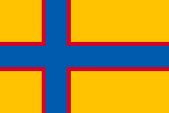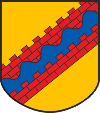Ingermanland |
|
|
|
| Übersicht – Contents: | |
Diese Seite ist Teil des Projektes
Ingermanland |
|
|
|
| Übersicht – Contents: | |
Flagge – Flag: |
|
 |
Nationalflagge – national flag, |
Bedeutung/Ursprung der Flagge – Meaning/Origin of the Flag: |
|
| Die Flagge Ingermanlands erinnert einerseits stark an die schwedische Flagge, da es bis 1719/1720 zu Schweden gehörte, und unter der schwedischen Herrschaft von Finnen besiedelt wurde. Zur Betonung der finnischen Identität der Bewohner Ingermanlands wurden schmale rote Trennstreifen eingefügt. Rot ist die Wappen- und Nationalfarbe von Finnland. Andererseits könnten die Farben auch auf das Wappen zurückgehen. | The flag of Ingria remembers on the one hand powerfully the swedish flag, seeing that it belongs to the years 1719/1720 to Sweden, and was settled under the swedish reign by Fins. To accent the finnish identity of the inhabitants of Ingria were inserted narrow red separating stripes. Red is the scutcheon colour and the national colour of Finland. On the other hand, the colours could also simply go back to the coat of arms. |
| Quelle/Source: Volker Preuß | |
Wappen – Coat of Arms: |
|
 |
Wappen von Ingermanland – coat of arms of Ingermanland Quelle/Source: Wikipedia (DA) |
Bedeutung/Ursprung des Wappens – Meaning/Origin of the Coat of Arms: |
|
| Das Wappen von Ingermanland stammt aus der schwedischen Zeit. Zu finden ist es im großen Siegel von König Karl XII. Es zeigt einen Fluss zwischen zwei Mauern. Es soll den Fluss Neva zwischen den Mauern der Festung Nyenskans symbolisieren. Das Siegel ist ein Schnitt, der keine Farben darstellt. Insofern gelten die Farben als angenommen. Der Fluss in Blau, die Mauern in Rot, das ist sicher. Der Untergrund könnte in jeder beliebigen Farbe gemeint gewesen sein. Gelb (Gold) galt wohl für schwedische Wappen als naheliegend. | The coat of arms of Ingria dates back to the Swedish period. It is found in the Great Seal of King Charles XII. It shows a river between two walls. It is said to symbolize the river Neva between the walls of the fortress Nyenskans. The seal is a draw that does not represent colors. In this respect, the colours are considered as probably. The river in blue, the walls in red, that's for sure. The base could have been in any color. Yellow (gold) was considered to be obvious for Swedish coats of arms. |
| Quelle/Source: Wikipedia (DA) | |
Landkarte – Map: |
Lage – Position: |
Zahlen und Fakten – Numbers and Facts: |
|
|
|
|
|
|
|
|
|
|
|
|
|
|
|
|
|
|
|
|
Ergänzende Informationen – Additional Informations: |
|
|
Dieser Text war auf der Webseite der UNPO, ca. 2010 zu finden als Ingermanland noch Mitglied dieser Organisation war: Allgemeines: Ingermanland – (Ingrien, Inkeri) historische Landschaft im Nordwesten Russlands, südlich des Finnischen Meerbusens und des Ladogasees und an beiden Ufern der Newa. Im Westen grenzt Ingermanland an Estland und im Süden und Osten entlang der Flüsse Luga, Oredesch, Tosna, Mga und Lowat. Die Fläche beträgt etwa 15.000 km². Bevölkerung: 6 Millionen Einwohner, davon allein in St. Petersburg ca. 5 Millionen, überwiegend Russen. Die Zahl der ingerischen Finnen (Ingerier), des historisch staatstragenden Volkes, beträgt 90.000, die meist in St. Petersburg und Umgebung leben. Viele leben auch in Karelien, in zentralen Regionen Russlands, in Zentralasien, in Finnland, Estland, Schweden, Kanada, in den USA und Australien. Sprache: Die ingerischen Finnen gehören zu den finno-ugrischen Völkern. Ihre Literatursprache ist Finnisch, wird beim Sprechen jedoch mit lokalen Dialekten vermischt. Bis 1995 wurde Finnisch nicht an Schulen unterrichtet, die Amtssprache war und ist Russisch. Organisation: Die ingerischen Finnen werden in der UNPO durch die Inkeri Liitto vertreten. Ihr Ziel ist die Erhaltung der ingerischen Finnen als ein Volk. Wirtschaft: Traditionelle Formen der Landwirtschaft sind teilweise gut erhalten, wenngleich die meisten ingerischen Finnen in den Industriebetrieben von St. Petersburg und seiner Umgebung oder in der Forstwirtschaft arbeiten. Geschichte: Im 17. Jahrhundert kam Ingermanland unter Schwedische Herrschaft, finnische Bauern wanderten ein. 1702 erwarb der russische Zar Peter der Große einen Zugang zur baltischen See und gründete dort, in Ingermanland, die neue Hauptstadt seines Reiches - Sankt Petersburg. 1700 bis 1721 Nordischer Krieg, um die Herrschaft in der Ostsee und ihren Randländern in Nord- und Osteuropa geführter Krieg, in dem Dänemark, Sachsen, Polen und Russland, seit 1713 auch Preußen und Hannover gegen Schweden kämpften. Karl XII. von Schweden unterlag 1709 Peter dem Großen bei Poltawa. Die wichtigsten Ergebnisse der Friedensschlüsse von Stockholm (1719/20), Frederiksborg (1720) und Nystad (1721): Hannover erhielt Bremen und Verden; Preußen gewann Vorpommern mit Stettin, Usedom und Wollin; an Russland fielen Livland, Estland, Ösel, Ingermanland und ein Teil Kareliens; Schweden mußte seinen alten Gottorfer Bundesgenossen (Nebenlinie des oldenburgisch-dänischen Königshauses) fallenlassen und trat seine beherrschende Stellung im Ostseeraum an das aufstrebende Rußland ab. 1920 wurde Ingermanland im Friedensvertrag von Tartu als Bestandteil Sowjetrusslands anerkannt. 1929 bis 1936 wurde die Mehrheit der ingerischen Finnen nach Sibirien, Zentralasien und auf die Halbinsel Kola deportiert. Die auf dies Art frei gewordenen Siedlungsräume wurden durch Neusiedler aus Russland besiedelt. 1943 wurde die ingerische Bevölkerung aus den Teilen Ingermanlands, die von der deutschen Wehrmacht bestzt waren, nach Finnland evakuiert. 1988 wurde die Organisation der ingerischen Finnen gegründet. Sie heißt Inkeri Liitto und wurde 1992 in die UNPO aufgenommen. 1993 wurden die Ingerier durch die russische Regierung rehabilitiert, erhielten jedoch nicht das Recht in ihre Heimat zurückzukehren. 1995 wurden drei Altersheime eröffnet, die von der Inkeri Liitto unter Mithilfe der finnischen Regierung und sozialer Organisationen gebaut wurden. Die erste finnische Schule wurde inzwischen in St. Petersburg eröffnet. Die russische Politik verletzt aber weiterhin die Rechte der Ingerier. Sie werden weder als ethnische Minderheit, noch als einheimische Bevölkerung anerkannt. Die örtlichen Organe haben keinerlei Entscheidung hinsichtlich des national-kulturellen Status der Ingerier getroffen. Es ist bisher auch keinerlei Verbesserung im Kampf der Ingerier für ihre Selbstbestimmung erreicht worden. Es ist schwer eine starke Stimme gegen die russischen Autoritäten zu erheben. |
This text was found on the website of the UNPO, ca. 2010 as an Ingerman country was still a member of this organization: General: Inkeri (Ingermanland, Ingria) historical landscape in northwestern Russia, south of the Finnish sea bosom and the Ladoga Sea and on both banks of the Neva. In the West, Ingermanland is bordered by Estonia and in the south and east along the rivers Luga, Oredezh, Tosna, Mga and Lovat. The area is about 5.800 q.mi. Population: 6 million inhabitants, of which even in St. Petersburg about 5 millions, mostly Russians. The number of Ingermanland Finns, the historically the state-carrying nation, is 90.000, mostly living in St. Petersburg and the surrounding area. Many of them also live in Karelia, central regions of Russia, Central Asia, Finland, Estonia, Sweden, Canada, in the USA and Australia. Language: The Ingermanland Finns belong to the Finno-Ugric peoples. Their literary language is Finnish, but is mixed with local dialects in speaking. Until 1995, Finnish was not taught in schools, the official language was and is Russian. Organization: The Ingermanland Finns are represented in the UNPO by the Inkeri Liitto Organization. Their goal is to preserve the Ingrian Finns as a people. Economy: Traditional forms of agriculture are partly well preserved, although most of the Ingermanland Finns work in the industrial plants of St. Petersburg and its surroundings or in the forestry sector. History: In the 17th century Ingermanland came under Swedish rule, Finnish peasants immigrated. In 1702 the Russian Tsar Peter the Great gained access to the Baltic Sea and founded there, in Ingermanland, the new capital of his empire - Saint Petersburg. From 1700 to 1721 Nordic War, fought the rule in the Baltic Sea and its peripheral countries in Northern and Eastern Europe, in which Denmark, Saxony, Poland and Russia, and since 1713 also Prussia and Hanover fought against Sweden. King Charles XII. of Sweden defeated in 1709 against Peter the Great near Poltava. The most important results of the peace agreements of Stockholm (1719/20), Frederiksborg (1720) and Nystad (1721): Hanover gets Bremen and Verden; Prussia gets Western Pomerania with Stettin, Usedom and Wollin; to Russia came Livonia, Estonia, Osel, Ingermanland and parts of Karelia; Sweden had to drop its old Gottorf allies (the sideline of the Oldenburg-Danish royal family) and withdrew its dominant position in the Baltic Sea region to the rising Russia. In 1920 Ingermanland was recognized in the Treaty of Tartu as part of Soviet Russia. From 1929 to 1936, the majority of Ingermanland Finns were deported to Siberia, Central Asia and the Kola Peninsula. The settlements, vacated in this way, were settled by settlers from Russia. In 1943 the population of Ingermanland was evacuated from those parts of the country, which were occupied by the German Wehrmacht, to Finland. In 1988 the organization of the Ingermanland Finns was founded. Its name is Inkeri Liitto and it was admitted to the UNPO in 1992. In 1993, the Ingermanland Finns were rehabilitated by the Russian government but it was not given the right to return to their homeland. In 1995 were opened three old people's homes, built by Inkeri Liitto with the help of the Finnish government and social organizations. The first Finnish school was opened in St. Petersburg. The Russian policy continues to violate the rights of the Ingermanland Finns. They are not recognized as an ethnic minority, nor as a native population. The local authorities have made no decision regarding the national cultural status of the Ingermanland Finns. So far, no improvement has been achieved in the struggle of the Ingerians for their self-determination. It is difficult to raise a strong voice against the Russian authorities. |
Ursprung des Landesnamens – Origin of the Country's Name: |
|
| Ingermanland, der Name des Landes geht auf die finnischen Einwohner des Landes zurück, den westfinnischen Stamm der Ingern. Auf deutsch heißen sie Ingrier oder Ingern, auf russisch Ischoren, auf finnisch Ingrikot. Der Anteil der Ingrier innerhalb der in Ingermanland lebenden Finnen beträgt 1%. | Ingermanland, the name of the country goes back to the Finnish inhabitants of the country, the western Finnish tribe of the Izhorians (Ingrians). In German they are called Ingrians or infondly, in Russian ischoruses, in Finnish Ingrikot. The proportion of Ingrians within the Finns living in Ingerman is 1%. |
| Quelle/Source: Wikipedia (DE), Pierer's Universal-Lexikon | |